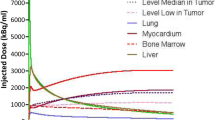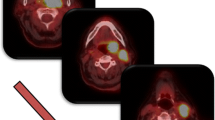Abstract
Medical imaging plays an important role in radiotherapy. Dose painting consists in the application of a nonuniform dose prescription on a tumoral region, and is based on an efficient segmentation of Biological Target Volumes (BTV). It is derived from PET images, that highlight tumoral regions of enhanced glucose metabolism (FDG), cell proliferation (FLT) and hypoxia (FMiso). In this paper, a framework based on Belief Function Theory is proposed for BTV segmentation and for creating 3D parametric images for dose painting. We propose to take advantage of neighboring voxels for BTV segmentation, and also multi-tracer PET images using information fusion to create parametric images. The performances of BTV segmentation was evaluated on an anthropomorphic phantom and compared with two other methods. Quantitative results show the good performances of our method. It has been applied to data of five patients suffering from lung cancer. Parametric images show promising results by highlighting areas where a high frequency or dose escalation could be planned.
Chapter PDF
Similar content being viewed by others
Keywords
References
Ling, C.C., Humm, J., Larson, S., Amols, H., Fuks, Z., Leibel, S., Koutcher, J.A.: Towards multidimensional radiotherapy (MD-CRT): biological imaging and biological conformality. Int. J. Radiat. Oncol. Biol. Phys. 47, 551–560 (2000)
Vauclin, S., Doyeux, K., Hapdey, S., Edet-Sanson, A., Vera, P., Gardin, I.: Development of a generic thresholding algorithm for the delineation of 18FDG-PET-positive tissue: application to the comparison of three thresholding models. Phys. Med. Biol. 54(22), 6901–6916 (2009)
Geets, X., Lee, J.A., Bol, A., Lonneux, M.: A gradient-based method for segmenting FDG-PET images: methodologie and validation. Eur. J. Nucl. Med. Mol. Imaging 34, 1427–1438 (2007)
Hatt, M., Cheze-Le Rest, C., Turzo, A., Roux, C., Visvikis, D.: A Fuzzy Locally Adaptive Bayesian Segmentation Approach for Volume Determination in PET. IEEE Trans. Med. Imaging 28(6), 881–893 (2009)
Belhassen, S., Zaidi, H.: A novel fuzzy C-means algorithm for unsupervised heterogeneous tumor quantification in PET. Med. Phys. 37, 1309–1324 (2010)
Dempster, A.P.: Upper and lower probabilities induced by a multivalued mapping. Ann. Math. Stat. 38, 225–339 (1967)
Shafer, G.: A mathematical theory of evidence. Princeton University Press, Princeton (1976)
Smets, P., Kennes, R.: The Transferable Belief Model. Artif. Intell. 66, 191–234 (1994)
Bloch, I.: Defining belief functions using mathematical morphology - Application to image fusion under imprecision. Int. J. of Approx. Reason. 48(2), 437–465 (2008)
Bezdek, J.C.: Pattern Recognition with Fuzzy Objective Function Algorithms. Plenum Press, New York (1981)
Viola, P., Wells III, W.M.: Alignment by Maximization of Mutual Information. Int. J. Comput. Vision 24(2), 137–154 (1997)
Author information
Authors and Affiliations
Editor information
Editors and Affiliations
Rights and permissions
Copyright information
© 2012 Springer-Verlag Berlin Heidelberg
About this paper
Cite this paper
Lelandais, B., Gardin, I., Mouchard, L., Vera, P., Ruan, S. (2012). Segmentation of Biological Target Volumes on Multi-tracer PET Images Based on Information Fusion for Achieving Dose Painting in Radiotherapy. In: Ayache, N., Delingette, H., Golland, P., Mori, K. (eds) Medical Image Computing and Computer-Assisted Intervention – MICCAI 2012. MICCAI 2012. Lecture Notes in Computer Science, vol 7510. Springer, Berlin, Heidelberg. https://doi.org/10.1007/978-3-642-33415-3_67
Download citation
DOI: https://doi.org/10.1007/978-3-642-33415-3_67
Publisher Name: Springer, Berlin, Heidelberg
Print ISBN: 978-3-642-33414-6
Online ISBN: 978-3-642-33415-3
eBook Packages: Computer ScienceComputer Science (R0)




